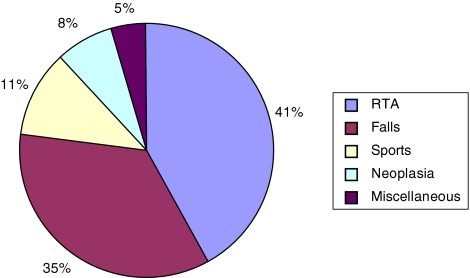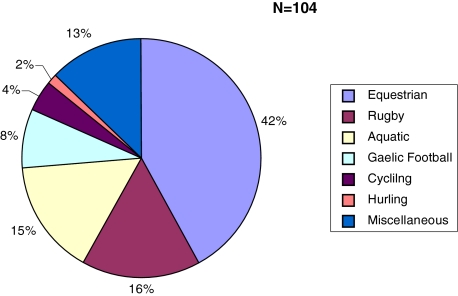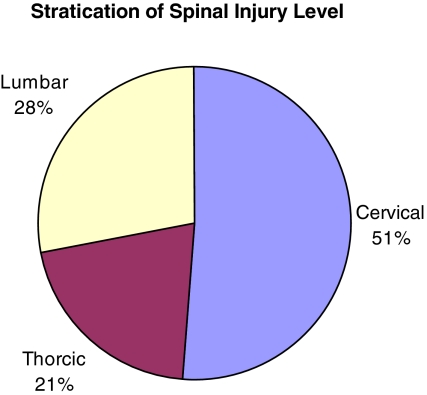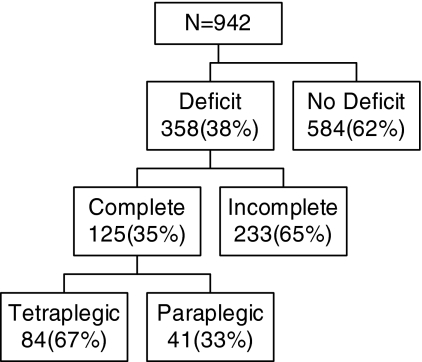Abstract
This prospective demographic study was undertaken to review the epidemiology and demographics of all acute admissions to the National Spinal Injuries Unit in Ireland for the 5 years to 2003. The study was conducted at the National Spinal Injuries Unit, Mater Miscericordiae University Hospital, Dublin, Ireland. Records of all patients admitted to our unit from 1999 to 2003 were compiled from a prospective computerized spinal database. In this 5-year period, 942 patients were acutely hospitalized at the National Spinal Injuries Unit. There were 686 (73%) males and 256 (27%) females, with an average age of 32 years (range 16–84 years). The leading cause of admission with a spinal injury was road traffic accidents (42%), followed by falls (35%), sport (11%), neoplasia (7.5%) and miscellaneous (4.5%). The cervical spine was most commonly affected (51%), followed by lumbar (28%) and thoracic (21%). On admission 38% of patients were ASIA D or worse, of which one-third were AISA A. Understanding of the demographics of spinal column injuries in unique populations can help us to develop preventative and treatment strategies at both national and international levels.
Keywords: Spinal, Injuries, Demographics, Epidemiology
Introduction
The incidence of spinal injury is region specific due to unique geographic and demographic characteristics. Epidemiologic studies of spinal cord injuries are well documented in the literature [1, 5, 9, 15, 24, 26]. Cord injured patients represent only a fraction of all spinal column injuries. There are few population-based studies that define the epidemiology or demographics of all spinal column injures and those that exist are a predominantly retrospective [14, 19].
The annual incidence of SCI in European countries varies from 13.9 to 19.4 per million population compared to 43.3–51 in North America [1, 5, 9, 15, 24, 26]. The early pre-hospital mortality ranges from 48.3 to 79%, while the inpatient mortality ranges from 4.4 to 16.7% [5, 26]. The prevalence of SCI in the US is reported to range from 721 to 906 per million population, being 681 and 280 per million population in Australia and Europe, respectively [4, 12, 13]. The reported annual incidence rate of traumatic (non-osteoporotic) spinal fractures varies between 19 and 88 per 100,000 [8, 18]. A greater understanding of the patterns of injury, presentation and complications has lead to improved survival.
An understanding of demographic and injury-related trends in the spinal injured population helps directs health care plans. In the current health care climate it is our role as clinicians to examine the epidemiology and demographics of spinal injury so that cost projections, allocation of resources and planning of disability and rehabilitation services can be made. It also helps to develop and implement prevention strategies targeted at reducing the incidence of these devastating injuries. Successful examples of the above include mandatory back brace utilisation in equestrian sports and seat belt legalisation for motorists [7, 10]. Continued analysis of the demographics of spinal injuries will shed light on the success and failures of these prevention strategies.
The aim of this study was to examine the epidemiology and demographics of acute admissions to the National Spinal Injuries Unit in Ireland from the 5 years to 2003.
Materials and methods
The National Spinal Injuries Unit is the tertiary referral centre for major spinal injury management in Ireland serving a population of 4.5 million and a geographical area of 70.280 km2. Records of all patients admitted with a spinal injury from 1999 to 2003 were compiled from a prospective computerized spinal database. Data investigated included patient demographics, mechanism of injury, injury pattern, neurological status, hospital stay, and treatment. The aetiology was categorised as road traffic accident (RTA), accidental falls, sport, neoplasia and miscellaneous. The miscellaneous group included assault, cauda equina, infective and degenerative spinal diseases. Data on deaths due to SCI that occurred prior to hospitalisation was not included.
Results
Between 1999 and 2003, 942 patients were hospitalized with a spinal column injury. There were 686 (73%) males and 256 (27%) females, with an average age of 32 years (range 16–84 years). Table 1 shows the age distribution for patients admitted over the 5-year period. The causes of acute spinal injury are summarized in Fig. 1. The leading cause of spinal injury was RTA (396, 42%), followed by falls (329, 35%), sport (104, 11%), neoplasia (71, 7.5%) and miscellaneous (42, 4.5%). RTAs were the leading cause of injury in those aged 16–44; after 45, the leading cause was a fall. Excess speed and consumption of alcohol were found to be contributing factors in over 55% of RTAs. Associated significant extra-spinal injuries were seen in 39% of RTA patients. The most common sport responsible for a spinal injury was equestrian events (41.8%) followed by rugby (16.3%), aquatic/diving (15.3%), Gaelic football (8.1%), cycling (4.2%), hurling (1.5%), and miscellaneous (12.7%) (Fig. 2).
Table 1.
Age distribution for spinal admissions
| Age (year) | Incidence (%) |
|---|---|
| <20 | 8 |
| 21–30 | 33 |
| 31–40 | 19 |
| 41–50 | 13 |
| 51–60 | 15 |
| >60 | 12 |
Fig. 1.
Aetiology of spinal injury
Fig. 2.
Sports related spinal injuries
The stratification of spinal injury by level revealed that the cervical spine was most commonly affected (51%), followed by lumbar (28%) and thoracic spine (21%) (Fig. 3). In our study 9% had more than one region and 40% had more than one vertebral level affected.
Fig. 3.
Distribution of injury by spinal level
Surgical intervention was required in 323 patients (35%). These included patients both with and without a neurological deficit. Halo application in 148 patients (16%) and the remaining 453 patients (49%) were managed conservatively (Fig. 4).
Fig. 4.
Treatment
On admission, neurological deficit was seen in 358 patients (38%). Of those with a neurological deficit, 233 patients (65%) were incomplete and 125 (35%) were complete, of which 41 patients (33%) were paraplegic and 84 (67%) were tetraplegic (Fig. 5).
Fig. 5.
Neurological assessment on admission
The majority of spinal injuries occurred during the summer and autumn months; July was the highest, followed by September. The average inpatient hospitalisation was 46.4 days (range 4–246 days) and 28% of patients required further treatment in an inpatient rehabilitation facility following their hospital stay. The inpatient mortality was 3.9% (38 patients) (Fig. 6).
Fig. 6.
In-hospital deaths
Discussion
Traumatic injury is the leading cause of death and long-term morbidity in the young adult population [25]. Spinal column and cord injury are an important cause of morbidity among young people in Ireland, with 60% of injuries occurring in those under 40 years of age. Males are consistently at a higher risk across all aetiologies of spinal injury [26]. The severity of these injuries is compounded by the risk of long-term neurological deficit. In our study, for those who sustained permanent complete paralysis, 67% were tetraplegic.
Understanding the factors that contribute to spinal injuries is paramount in injury prevention.
In managing these patients it is important to evaluate the whole spine and to look for associated injuries. In our study, 9% had more than one region affected and 40% had more than one vertebral level involved. These figures are in keeping with previous reports in the literature [18]. The reported incidence of significant injuries such as traumatic brain injury or major chest injuries ranges from 20 to 57% [21]. Typically these multi-system traumas occur in RTAs. 5–10% of head-injury patients have an associated spinal injury. Conversely, 25–50% of patients with acute spinal injuries have an associated head injury [21]. Associated injuries can significantly affect prognosis in spinal injuries [20]. Spinal injury in the context of multiple trauma carries a poorer prognosis than isolated axial injury [20]. Neurological recovery has been shown to be reduced and mortality increased in patients with spinal injuries and other systemic injuries [23]. The frequent association between SCI and fractures of the appendicular skeleton and pelvis reinforces the need to maintain a high index of suspicion when evaluating the neurologically injured patient due to the potential for symptom masking by the underlying neurological deficit.
Of those with a neurological deficit, 35% in our study were ASIA A. There is a changing trend in the pattern of spinal cord injury and the proportion of complete to incomplete and paraplegic to tetraplegic [26]. The reasons for this change are multiple and include improved initial care and retrieval systems, greater awareness of the importance of immobilisation after injury and methods of limiting secondary injury such as aggressive avoidance of hypotension, hypoxia and improved nursing of patients.
Primary prevention is the best management for spinal injury. RTAs accounted for the majority of spinal injuries in this study. RTAs have a multi-factorial aetiology; however, driver behaviour is one of the most important factors. Other factors include vehicle safety, car tests, and improvements in road infrastructure. Minimum vehicle safety standards have reduced the number of RTA fatalities [17]. Random breath testing has significantly reduced the incidence of driving and drinking and consequent accidents and death [6]. A number of countries have implemented a cumulative penalty system for driving offences with success [11, 16]. In October 2002 a new system of cumulative penalty points for speeding was introduced in Ireland. In the first 6 months of the system there were 140 RTA deaths compared to 208 in the previous year and data from our unit showed that there was 48% reduction in RTA related spinal injury [23]. This suggests that driving behaviour may be modified to reduce the incidence of SCI. However, the initial reduction in RTA related spinal injuries and deaths were not maintained in the second 6 months of the new system.
Studies on the incidence of sports-related spinal injuries in other countries have identified many risk factors associated with these injuries. They tend to be associated with inexperience and poor knowledge of the inherent dangers of the sport, inadequate coaching and practice facilities, lack of supervision, protective equipment and strict refereeing [2, 22]. Cantu et al. [3] reported how teaching the fundamental techniques of the game, equipment standards, and improved medical care both on and off the playing field led to an amazing 270% reduction in permanent spinal cord injury in American football.
In conclusion, this paper outlines the epidemiology of spinal injuries admitted to a national centre and the data included can be used to plan future unit development, identify areas where preventative campaigns can be targeted and highlight the economic cost of acute spinal injury.
References
- 1.Blumer CE, Quine S. Prevalence of spinal cord injury: an international comparison. Neuroepidemiology. 1995;14:258–268. doi: 10.1159/000109801. [DOI] [PubMed] [Google Scholar]
- 2.Boden Bp, Jarvis CG. Spinal injuries in sport. Neurol Clin. 2008;26:63–78. doi: 10.1016/j.ncl.2007.12.005. [DOI] [PubMed] [Google Scholar]
- 3.Cantu RC, Mueller FO. Catastrophic football injuries: 1977–1998. Neurosurgery. 2000;47:673–675. doi: 10.1097/00006123-200009000-00029. [DOI] [PubMed] [Google Scholar]
- 4.Dahlberg A, Kotila M, Leppanen P, Kautiainen H, Alaranta H. Prevalence of spinal cord injury in Helsinki. Spinal Cord. 2005;43:47–50. doi: 10.1038/sj.sc.3101616. [DOI] [PubMed] [Google Scholar]
- 5.Dryden DM, et al. The epidemiology of traumatic spinal cord injury in Alberta, Canada. Can J Neurol Sci. 2003;30:113–121. doi: 10.1017/s0317167100053373. [DOI] [PubMed] [Google Scholar]
- 6.Dunbar JA, Penttila A, Pikkarainen J. Drinking and driving: success of random breath testing in Finland. Br Med J (Clin Res Ed) 1987;295:101–103. doi: 10.1136/bmj.295.6590.101. [DOI] [PMC free article] [PubMed] [Google Scholar]
- 7.Healy DG, Connolly P, Stephens MM. Speed and spinal injuries. Injury. 2004;35:908–912. doi: 10.1016/j.injury.2003.12.007. [DOI] [PubMed] [Google Scholar]
- 8.Hu R, Mustard C, Burns C. Epidemiology of incident spinal fracture in a complete population. Spine. 1996;21(4):492–499. doi: 10.1097/00007632-199602150-00016. [DOI] [PubMed] [Google Scholar]
- 9.Kraus JF (1980) Injury to the head and spinal cord: the epidemiological relevance of the medical literature published from 1960–1978. J Neurosurg Suppl:S3–S10 [PubMed]
- 10.Loder RT. The demographics of equestrian-related injuries in the Unites States: injury patterns, orthopaedic specific injuries, and avenues for injury prevention. J Trauma. 2008;65(2):447–460. doi: 10.1097/TA.0b013e31817dac43. [DOI] [PubMed] [Google Scholar]
- 11.Lenehan B, Street J, Buckley J, Barry K, Mullan GB. Immediate effects of ‘Penalty Points’ legalisation on acute hospital trauma services. Injury. 2005;36:912–916. doi: 10.1016/j.injury.2005.03.008. [DOI] [PubMed] [Google Scholar]
- 12.National Spinal Cord Injury Database United States (http://www.spinalcord.uab.edu)
- 13.O’Connor PJ. Prevalence of spinal cord injury in Australia. Spinal Cord. 2005;43:42–46. doi: 10.1038/sj.sc.3101666. [DOI] [PubMed] [Google Scholar]
- 14.Payne SR, Wallwr JA. Trauma registry and trauma centre biases in injury research. J Trauma. 1989;29:424–429. doi: 10.1097/00005373-198904000-00002. [DOI] [PubMed] [Google Scholar]
- 15.Pickett W, Simpson K, Walker J, Brison RJ. Traumatic spinal cord injury in Ontario, Canada. J Trauma. 2003;30:113–121. doi: 10.1097/01.TA.0000034228.18541.D1. [DOI] [PubMed] [Google Scholar]
- 16.Poli de Figueiredo LF, Rasslan S, Bruscagin V, Cruz R, Rocha e Silva M. Increases in fines and driver licence withdrawal have effectively reduced immediate deaths from trauma on Brazilian roads: the first year report on the new traffic code. Injury. 2001;32:91–94. doi: 10.1016/S0020-1383(00)00172-8. [DOI] [PubMed] [Google Scholar]
- 17.Robertson LS. Reducing deaths on the road: the effects of minimum safety standards, published crash tests, seat belts and alcohol. Am J Public Health. 1996;86:31–34. doi: 10.2105/ajph.86.1.31. [DOI] [PMC free article] [PubMed] [Google Scholar]
- 18.Roche SJ, Sloane PA, Mcabe JP. Epidemiology of spine trauma in an Irish regional trauma unit: a 4-year study. Injury. 2008;39(4):436–442. doi: 10.1016/j.injury.2007.12.012. [DOI] [PubMed] [Google Scholar]
- 19.Saboe LA, Reid DC, Davis LA, Warren SA, Grace MG. Spine trauma and associated injuries. J Trauma. 1991;31:34–38. doi: 10.1097/00005373-199101000-00010. [DOI] [PubMed] [Google Scholar]
- 20.Schinkel C, Frangen TM, Kmetic A, Andress HJ, Muhr G. Spinal fractures in multiply injures patients: an analysis of the German Trauma Society’s Trauma Register. Unfallchirurg. 2007;110(11):946–952. doi: 10.1007/s00113-007-1351-2. [DOI] [PubMed] [Google Scholar]
- 21.Sekhon LH, Fehlings MG. Epidemiology, demographics, and pathophysiology of acute spinal cord injury. Spine. 2001;26:S2–S12. doi: 10.1097/00007632-200112151-00002. [DOI] [PubMed] [Google Scholar]
- 22.Silver JR. Spinal injuries resulting from horse riding accidents. Spinal Cord. 2002;40:264–271. doi: 10.1038/sj.sc.3101280. [DOI] [PubMed] [Google Scholar]
- 23.Tator CH. Epidemiology and general characteristics of the spinal cord-injured patient. In: Tator CH, Benzel EC, editors. Contemporary management of spinal cord injury: from impact to rehabilitation. 3. Park Ridge, IL: American Association of Neurological Surgeons; 2000. pp. 15–19. [Google Scholar]
- 24.Tricot A. Etiologie et epidemiologie des lesion medulaires. In: Maury M, editor. La paraplegia. 1. Paris: Flammarion Medecine-Science; 1981. pp. 1–8. [Google Scholar]
- 25.Statistical WHO Information System (WHOSIS) (2007)
- 26.Wyndaele M, Wyndale J-J. Incidence, prevalence and epidemiology of spinal cord injury: what learns a worldwide literature survey? Spinal Cord. 2006;44:523–529. doi: 10.1038/sj.sc.3101893. [DOI] [PubMed] [Google Scholar]








